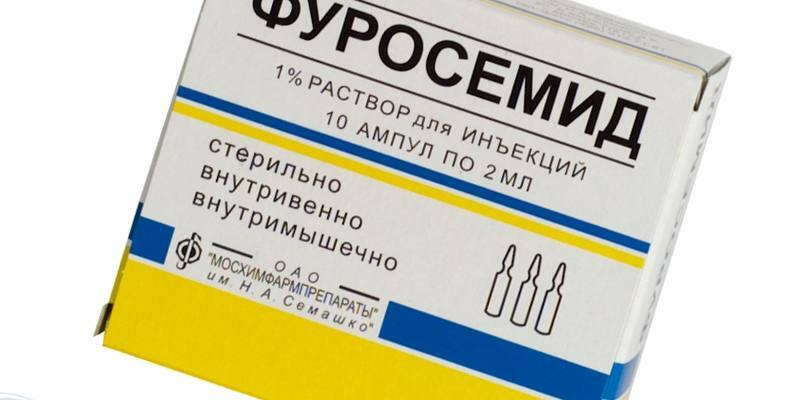
Contents of the page
- 1 Furosemide tablets - action of
- 2 Producers and form of
- 3 Furosemide tablets
- 4 Solution for injections
- 5 Price
- 6 Feedback on application of
Modern pharmacology has several groups of diuretics that differ in their properties and signs of action. The most popular of all types of diuretics are potent or loop diuretics, the most common of which can be called Furosemide.
Diuretics play an important role in the therapy of many serious diseases. Virtually none of the directions of medicine can do without diuretics. This is a vast group of drugs whose chemical structure helps to remove accumulated fluid from the body. Diuretics help the renal tubules to reduce absorption of salts and water, accelerate the formation of secondary urine and facilitate its natural secretion.
The ability of diuretics to release tissues and cavities from excess fluid helps reduce blood pressure, improves the efficiency of treatment of cardiac muscle and vascular diseases, many kidney and liver diseases, and the removal of all edema, regardless of the cause of the formation.
Tablets Furosemide - the action of the drug

The main purpose of potent diuretics is the rapid arrest of a severe condition, which requires emergency care. Instructions for use Furosemide notes a rapid effect, occurring almost immediately after taking the drug inside. At the same time, the duration of the diuretic action of Furosemide lasts no more than 2 hours, therefore it is ineffective for a long course of treatment, but is used only in emergency measures.
As a powerful diuretic loop diuretic, Furosemide actively removes sodium and chlorine ions, and also promotes the excretion of potassium, magnesium and calcium ions. Penetration of the drug into the renal tubules of the thick segment of Henle loops stops the absorption of sodium and chlorine. As a consequence of this action, secondary elimination of the fluid and enhanced formation in the distal sections of the renal tubules of potassium ions arise, simultaneously capturing the molecules of calcium and magnesium.
Furosemide affects the redistribution of internal blood flow to the kidneys and the release of renal mediators inside. The drug does not cause the body to become addictive, so even long-term use does not affect the effectiveness of its action.
The urgent action of Furosemide in heart failure is explained by the vasodilating ability of the drug, which quickly restores the lumen of large venous vessels, thereby removing the increased load from the cardiac muscle. Rapid relief of the hypertensive crisis is possible due to the weakening of the tone of the smooth musculature of the vessel walls, caused by a natural decrease in the volume of circulating blood.
After absorption of the drug, bioavailability will be from 70% to 100%, depending on the form of the drug. The maximum concentration of the active substance in the blood will be directly proportional to the dosage of the preparation and the route of administration. More than 90% of the molecules of the active substance Furosemide binds to albumins( proteins), so it can easily penetrate through the placental barriers and be excreted into breast milk.
Conversion of Furosemide components occurs in liver cells where it is converted to metabolites such as glucuronide. Both the drug itself and its metabolites are rapidly excreted from the body by the urinary system. Half-life does not exceed 1.5-2 hours. During this time more than 60% of the drug goes out, the rest will be removed with urine or feces within 24 hours after admission.
Manufacturers and Form of Release
The original preparation Furosemide is manufactured by several pharmaceutical companies, known manufacturers of medicines from Canada, Bulgaria, Russia, India, Poland and Germany. The drug is available in two pharmaceutical forms:
- Furosemide tablets.
- Furosemide solution for intramuscular and intravenous administration in ampoules.
Each dosage form has its own distinctive features of action on the body, and is used in various situations.
Furosemide tablets
This form of diuretic is available in the form of round pills of yellowish white color. The surface of the tablets has a convex shape and a transverse division. The amount of active ingredient in one tablet can be 0, 005 g, 0.02 g, 0.04 g, 0.5 g. The tablets are packaged in carton packs, each containing 50 pills.
The most common form available on sale of our pharmacies is Furosemide tablets containing 40 mg.
In addition to Furosemide, each tablet contains auxiliary components, the combination of which differs depending on the manufacturer's company. Usually, these are common substances in pharmacology that do not cause a negative reaction. But, if you are prone to allergies, be sure to check with your purchase how to take Furosemide, and what components contain the composition of the tablets.
Action of tablets
Furosemide tablets are taken orally, so the main absorption of the active substance takes place in the gastrointestinal tract. The effect of gastric juice slightly reduces the bioavailability of the active component, and it is 64%.
The therapeutic effect after taking the tablets is reached within the first hour, and lasts no more than 4-5 hours. The activity of Furosemide manifests itself when any form of acidic equilibrium changes. And, considering that Furosemide inhibits the absorption of calcium and sodium molecules, but practically does not affect the process of reabsorption( absorption, absorption) of potassium, it can be prescribed for the treatment of pathologies of any origin.
Indications for use of tablets

Tablets Furosemide equally effectively help in the emergence of stagnant phenomena, both in the large and in small circles of the circulation, if the cause of the pathology is associated with a lack of cardiac activity. In addition, the action of the pills perfectly helps to cope with such severe conditions as:
- cerebral edema;
- portal hypertension for cirrhosis;
- hypertensive crisis;
- poisoning of the body with barbiturates;
- acute and chronic form of renal failure;
- edema of the upper and lower respiratory tract;
- arterial hypertension, with persistent high rates.
Furosemide tablets are prescribed for patients with pathologically high values in the serum of calcium, potassium and sodium, with premenstrual tension syndrome, and stabilization of the condition in severe heart failure.
Instructions for use and dosage
The effectiveness of Furosemide in tablets is directly dependent on food intake. Nutrient components coming with food, enhance the therapeutic effect. Therefore, take the drug should always be before meals, and wash down with a small amount of liquid.

Calculation of the dose of the drug is carried out by the doctor strictly individually, and depends on the complexity of the disease, the severity of edema and stagnant phenomena. The initial dosage usually does not exceed 40 mg of the active substance. Assign an appointment for the first pill of the appropriate concentration in the morning before meals. It is possible to increase the dose to 80 mg and 160 mg per day, if there is no desired effect.
It is important to keep the intervals between the methods of the drug - they should be at least 6 hours. To fix the achieved effect, further medication intake is reduced, and is no more than 20 mg - 40 mg, taken with an interval of one to two days. The maximum daily dose can not exceed 160 mg.
Furosemide tablets administration to patients with severe renal failure is distinguished from the generally accepted rules of drug use. For such patients, primary doses of the drug can reach 240 to 360 mg of active Furosemide. Only after receiving a positive effect, the volume of medication taken is reduced to the possible minimum.
Treatment of chronic form of hypertension is to take 20 mg or 40 mg. Furosemide at one time in the morning. In the event that hypertension is complicated by a weakened cardiac activity, Furosemide is administered in amounts of 80 mg once daily.
Side effects of

Since the drug belongs to the drugs group "B", self-treatment is strictly prohibited. Sale in pharmacies is possible only according to the prescription of the attending physician.
Being a potent drug, Furosemide can trigger the occurrence of side effects from various body systems:
- Cardiovascular system: blood pressure may drop dramatically, until the appearance of persistent hypotension. Perhaps the emergence of tachycardia( rapid heartbeat), a violation of the rhythm of the heart and a critical decrease in bcc.
- Central and peripheral nervous systems can respond with severe headaches and dizziness, convulsions and muscle spasms, general weakness and the appearance of drowsiness and insuperable fatigue. In addition, there may be apathy and confusion.
- GASTROINTESTINAL TRACT: a negative reaction is expressed in the absence of appetite, constant thirst and dry mouth, nausea, vomiting, constipation or diarrhea, exacerbation of chronic pancreatitis.
- Urinary system: possible a sharp decrease in the discharge of urine, until its complete delay. In addition, the occurrence of interstitial nephritis, the release of primary urine and the reduction of sexual function.
- In blood tests, the following phenomena are possible:
- thrombocytopenia;
- agranulocytosis;
- leukopenia.
- Endocrine system - may respond with exacerbation of gout, hyperglycemia( a sharp increase in blood sugar), hypotension and a critical decrease in sodium, potassium and chlorine in the serum.
Contraindications
Given the strength and complexity of the effect of Furosemide tablets on all internal systems of the body, there are a number of categorical contraindications to the use of the drug. Therefore, before drinking Furosemide, read this list:
- Chronically low calcium content in serum.
- Obstruction of the urinary canals, mechanical etiology( stones or swelling).
- Severe forms of impaired liver and kidney function.
- The first 20 weeks of pregnancy and the entire breastfeeding period.
- Renal failure, its terminal stage.
- Hypersensitivity or intolerance of the components that make up the drug.
Solution for injection

In cases where oral administration of Furosemide tablets is not possible, or when an immediate effect is required, the drug is administered intramuscularly or intravenously. Furosemide solution in ampoules is available for sale in two forms:
- Ampoules of 1ml containing 10 mg of active ingredient.
- Ampoules of 2 ml containing 20 mg of active Furosemide.
Ampoules are packed in cardboard boxes of 10 and 25 pieces.
Advantages of Furosemide Solution
Furosemide solution, administered bypassing the esophagus and stomach, has 100% bioavailability after administration. The therapeutic effect with intravenous administration is achieved within two to three minutes, and with the / m introduction for 15 to 20 minutes. The action of Furosemide continues for 2.5 - 3 hours.
Furosemide in ampoules is prescribed for the purpose of calling for forced diuresis or for a critical condition of the patient when emergency help is needed. In addition, the introduction of the drug directly into the blood reduces the load on the liver and adrenal glands. With this method of introducing Furosemide, large peripheral venous vessels expand, which contributes to the redistribution of the increased heart burden, significantly reducing the left ventricular filling and the level of pressure in the pulmonary arteries.
Indications for use of Furosemide solution
Furosemide solution in ampoules, is intended for intramuscular or intravenous administration for the purpose of rapid stabilization of the condition in pathologies such as:
- Severe edema of various etiologies:
- Severe form of chronic heart failure.
- Syndrome of portal hypertension developing on the background of cirrhosis of the liver.
- Extensive pulmonary edema.
- Cerebral edema developing after injury.
- Severe form of hypertensive crisis.
- Performing forced diuresis for the purpose of body deoxidation during poisoning.
Contraindications
Unlike tablets, Furosemide in ampoules has much fewer contraindications. These include conditions such as:
- Anuria in severe renal failure.
- Finding a patient in a coma or a previous condition.
- Severe violations of the water-salt balance. Two first trimester of pregnancy.
- Painful reaction of the body to preparations of the sulfonamide group.
Furosemide in pregnancy and during breastfeeding

Molecules of Furosemide transformed in the body have the ability to penetrate the cells of the placenta, and therefore, can affect the development of the fetus. Therefore, Furosemide during pregnancy in the first 20 weeks of pregnancy is strictly contraindicated, and in recent weeks, the use of the drug is assessed in terms of the predominance of benefits from taking over possible harm.
The lactation period is a definitive prohibition for the administration of Furosemide. In the event that the drug can not be avoided, you should stop feeding the baby.
Is it possible to drink Furosemide with alcohol?
The lion's share of deaths caused by simultaneous intake of drugs and alcohol is Furosemide. Furosemide refers to potent drugs. In addition to its main action, it has many side effects, negative effects. The strong effect of the drug on cardiac activity, liver and kidney function, as well as the respiratory system, together with the effects of alcohol, can lead to death.
The situation is complicated by the fact that Furosemide does not have a specific antidote. Therefore, in the vast majority of cases, doctors are simply powerless to help a person.
Price
![]() Depending on the concentration of the active substance and the manufacturer's firm, the price of Furosemide tablets ranges from 23 rubles.up to 33 rubles.for packing. The cost of the drug in the form of a solution is about 16-20 rubles.
Depending on the concentration of the active substance and the manufacturer's firm, the price of Furosemide tablets ranges from 23 rubles.up to 33 rubles.for packing. The cost of the drug in the form of a solution is about 16-20 rubles.
Before buying Furosemide in a pharmacy, you need to consult a doctor and get a prescription for the drug.
Feedback on the application of
Review No.1
After surgery for appendicitis, neither could I urinate. It's a very unpleasant situation, I do not want anyone to experience this. Excruciating pains not only from the operating wound, but also from the bladder. Thanks to the doctor, Furosemide will be appointed by the vein. After the dropper ended, the sister introduced the ampoule Furosemide. Literally in a few minutes I realized that such a supreme bliss. Thank you doctor and effective medicine Furosemide.
Oleg, 30 years - Kiev
Review No. 2
I want to sincerely thank the ambulance team that gave me life in this review. I have suffered hypertension of grade II for many years, and that day I forgot to take my medicine. The crisis broke out for lunch at work. I had never experienced such a horror, my heart is beating at my throat, my temples seem to burst now, my head can not be raised, and there is a constant urge to vomit.
A doctor arrived immediately injected me with some kind of injection, then they told me that it was Furosemide. You will not believe, but I felt relieved in a couple of minutes. The truth ran to the toilet 15 times, but this is nonsense, but what a relief. Still never helped me for such a short time and so effectively. Thanks to the competent doctors.
Irina, 48 years - Moscow
Review No. 3
I took the drug because of kidney failure. Really an effective remedy. But since it strongly affects the body, I do not advise you to self-medicate, this drug should be prescribed only by a doctor.
Елена, 31 year - Saratov



